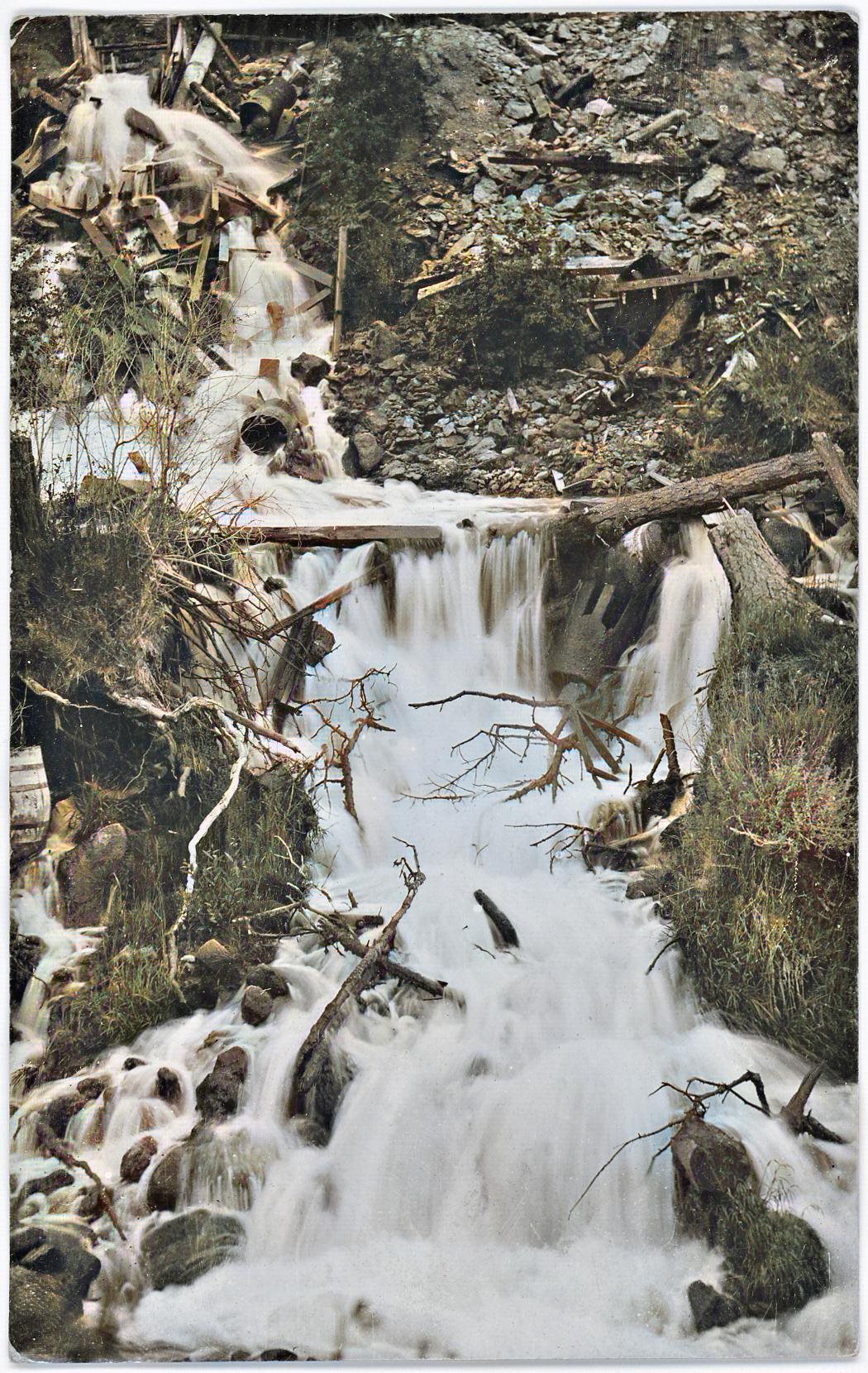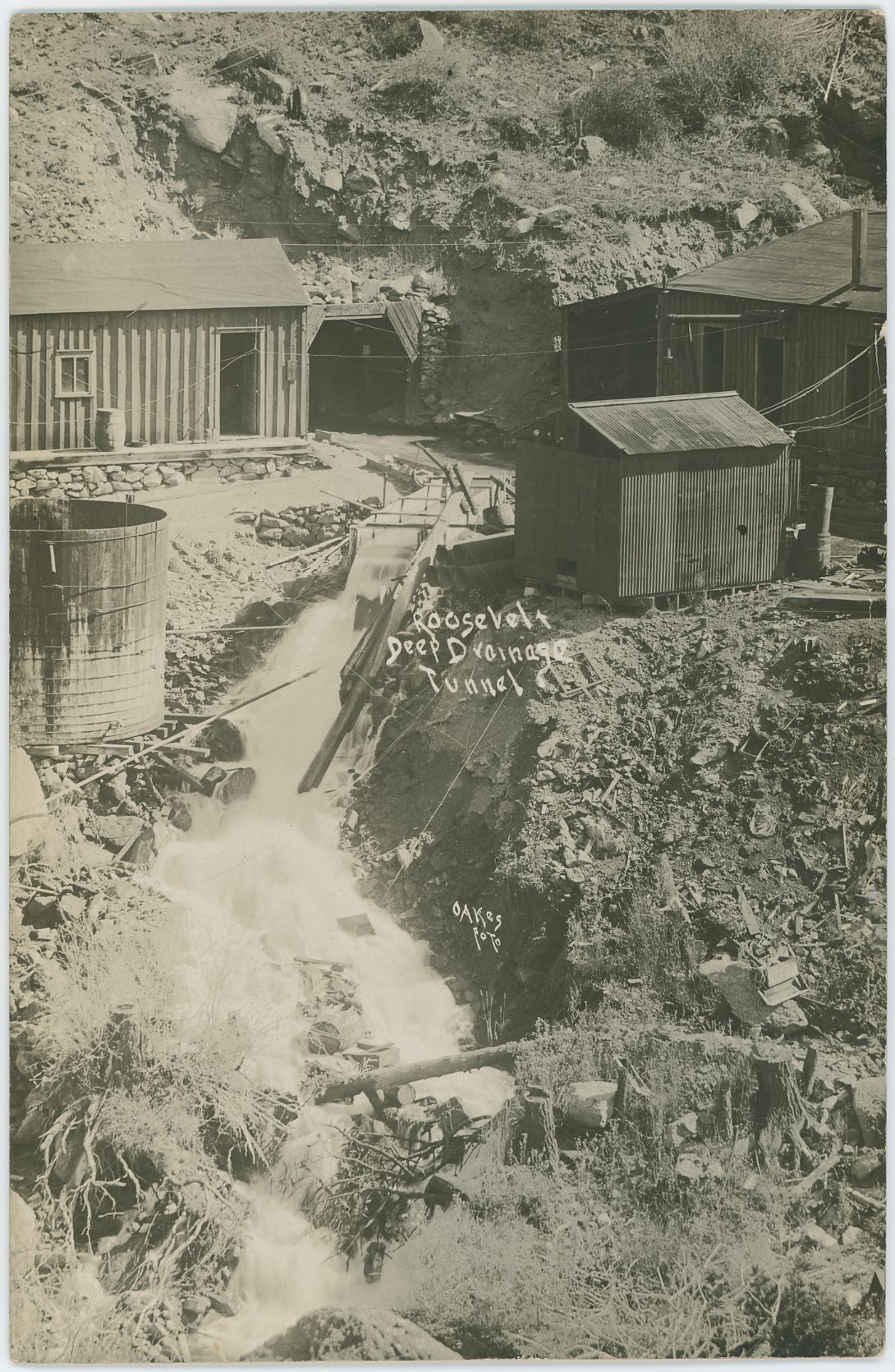-> HathiTrust Digital Library Site; Link to main text part of article.
Source only had one old base profile drawing of the water situation, so I re-used two images from my collection.
⤷The Roosevelt Tunnel.
By H. Foster Bain.
Abstracted and slightly rewritten from source text.
Colorado is becoming famous for its tunnels, a not unnatural result of its rough topography with high mountain ranges cut by deep canyons and gorges. Many of the railway lines pierce the mountains. Of greater immediate interest to mining engineers are the long adits and cross-cuts found in nearly all the mining districts and which local custom designates as tunnels.
Such tunnels are usually driven mainly to facilitate drainage of mines already well developed. To a subordinate degree they are expected to yield returns from cheaper transportation of ore, and to develop new ground. It is upon these claims that they must be justified since in Colorado, as elsewhere, repeated experience has shown that long tunnels are too expensive to be undertaken for prospecting alone.
Their utility lies in cheapening costs of production and rendering accessible orebodies already fairly assured. The Newhouse tunnel, at Idaho Springs, and the Roosevelt, at Cripple Creek, are probably the most important among those now being driven in Colorado. The former was originally projected mainly as a transportation agency and only later came to take serious account of possible revenue from drainage of wet mines.
The Roosevelt tunnel, on the other hand, is primarily for drainage. It is to enable the orebodies to be followed downward another 740 ft. without the enormous expense of pumping.
The Cripple Creek Drainage & Tunnel Co. was organized to drive a deep drainage tunnel to the heart of the productive district. For some time it had been apparent that the burden of pumping to reach lower horizons was bound to be a heavy one. The rocks which form the volcanic neck in which the veins of Cripple Creek occur, are so badly fissured and broken that the whole plug forms one vast sponge, and to work at any lower level, the ground-water throughout the area nearly three miles in diameter must be lowered.
F. L. Ransome has figured that the discharge from one foot of subsidence in this district amounts to 35,000,000 gal.
D. W. Brunton estimated that the various proposed tunnels would cost $380,000 to $570,000, or from $628 to $468 per vertical foot of depth drained, and would require 1.97 to 2.5 years to complete.
It was apparent that the task of providing drainage was peculiarly one for co-operative effort and accordingly after studies of the problem had been made by Seeley W. Mudd, D. W. Brunton, and others, it was determined to drive a deep-level tunnel.
Stock in the tunnel project is held by the various mining companies somewhat in proportion to the supposed future distribution of benefits. In contrast with the stock in the Newhouse tunnel, it is not expected to pay dividends, and its purchase has been considered to be of the nature of an assessment.
After 1400 ft. had been driven from the portal the further driving was contracted to A. E. Carlton at $28 per ft., and since then nearly two miles of advance has been made. An intermediate shaft 650 ft. deep was sunk, it being opened September 15, 1908. For a time progress was made at three headings. In June, 1909, connection was made between the portal and the west drift from the shaft, since which time only one face has been available.
Since the work is done as a private contract, details of cost can not be published. Through the courtesy, however, of V. H. Mann, Mr. Carlton's assistant, I am permitted to give the following regarding the cost of supplies on the basis of an average for seven months:
| Cost per foot. | |
|---|---|
| Powder | $4,715 |
| Air-drills | 1.089 |
| Steel, shovels and picks | 1.505 |
| Candles | 0.178 |
| Oil and waste | 0.178 |
| Blacksmith supplies | 0.457 |
Sum Cost per foot |
$8.122 |
The rate of progress has been as follows:
| Time. | Portal. | Intermediate Shaft. | |
|---|---|---|---|
| Feet | Feet | Note | |
| 1908. | |||
| February 1 to April 1 | 514 | ||
| April | 262 | ||
| May | 268 | ||
| June | 187 | ||
| July | 203 | ||
| August | 303* | ||
| September | 351 | ||
| October | 287 | 49 | 1 heading. |
| November | 360 | 141 | 1 heading. |
| December | 334 | 177 | 1 heading. |
| 1909. | |||
| January | 435 | 261 | 1 heading. |
| February | 290 | 601 | 2 headings. |
| March | 340 | 639 | 2 headings. |
| April | 316 | 670 | 2 headings. |
| May | 402 | 552 | 2 headings. |
| June | 62 | 498 | 2 headings. |
| July | 391 | 1 heading. | |
| August | 410 | 1 heading. | |
| September | 355 | 1 heading. | |
| October | 380 | 1 heading. | |
| * Began to use 100% powder. | |||
Leyner drills were used at the portal from the first and at the shaft after January 15. The tunnel has now been driven 1140 ft., and has 3250 more to go. It is estimated that the breccia will be reached by September next, at which time the mines will begin to drain.


